How to Make Sourdough Starter with Less Flour
I’ll teach you how to make Sourdough Starter from scratch without any commercial yeast. You need just 3 ingredients and 7-10 days to begin making real sourdough bread at home.
I’ve updated the process to use less than half the total amount of flour to create a lively and ready to use starter.
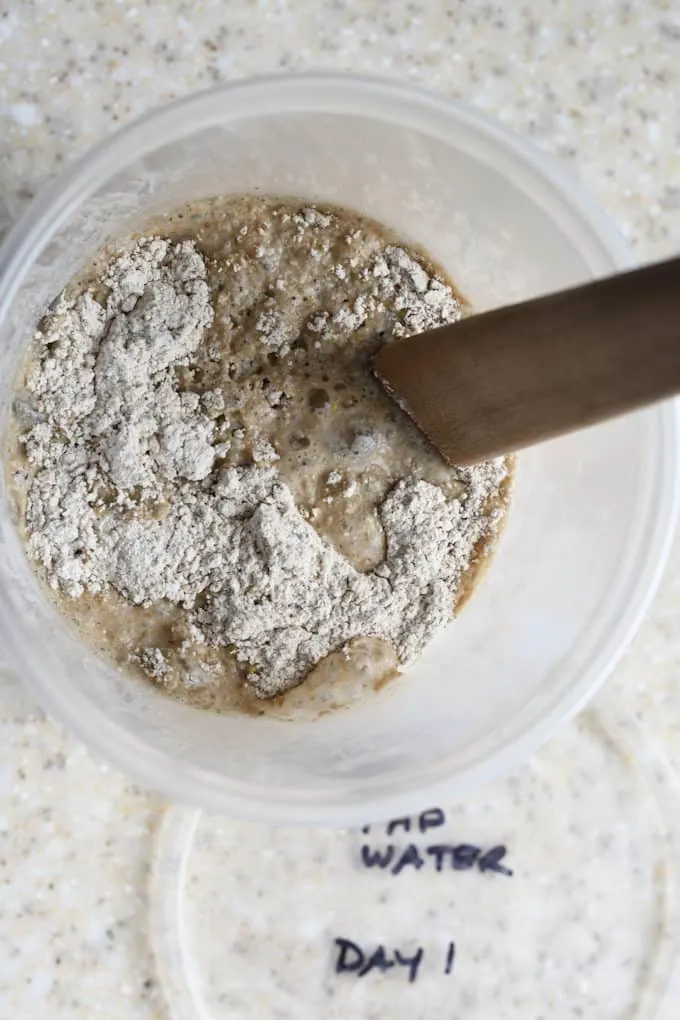
If you’re new to the world of sourdough baking, I’m so excited to get you “started” (pun intended!). Before you know it, I think you’ll be as obsessed as I am by the incredible living thing that is sourdough.
Yes, a sourdough starter is a living batter. It is built over several days to cultivate wild yeast from the environment and from the flour itself.
There are many ways to create and maintain sourdough starter. You may have read all sorts of warnings that you must use bottled water, that you should take it on vacation with you and treat it like a child. Relax, it’s really not that complicated.
I’m going to explain to you, step by step, how I created my starter. Along the way I’ll bust some myths about sourdough starters and, hopefully, show you that’s it’s really a very simple and forgiving process.
Once you have a starter, as long as you feed it periodically it can, theoretically, live forever.
How to make a sourdough starter using less flour
Although flour is usually inexpensive and easy to come by. It’s always good to create less waste.
So I revamped my process for creating a sourdough starter. With this new recipe the total amount of flour used is reduced from 30 oz (about 6 cups) down to less than 2 1/2 cups (12 oz).
The key is to keep the starter very small for the first 6 days of the process.
On day 7 we begin to bulk up the starter. By day 8, which is usually when the starter is active enough for baking, you’ll have a full 12 oz of starter. That’s enough to bake a loaf of bread and use what remains to continue feeding the starter.
All of my notes and photos for making a starter are still accurate with this smaller starter method.
Tips for making a successful Sourdough Starter:
- You don’t have to use bottled water to make sourdough starter. I mixed two starters side by side, one with bottled water and one with tap water. You can see in the process photos that they behaved exactly the same. As long as your tap water is good to drink and is not excessively chlorinated, there is no need to use bottled water. I baked with both starters with good results.
- I like to begin the starter with half all purpose and half whole grain rye flour. The wild yeast likes the extra nutrients in the whole grain flour.
- The whole grain flour gives the starter a bit of a boost and nice flavor, but if you can just all purpose flour is that’s what you have on hand.
- This is a 100% hydration starter. That simply means that it is made and replenished with equal weights of flour and water.
- For best results, weigh your ingredients. The weight of the flour can vary based on how you fill a measuring cup. Weight measurements are most consistent and accurate, especially when working with small amounts in the beginning of the process.
- The warmer the room, the faster your starter will activate. Since I was working in the winter months, I placed my starter near the furnace in our basement.
- About day 4 or 5, the starter may start to smell cheesy (like sour milk) and may not rise as much. Don’t give up! The smell will gradually become more yeasty/fermenty and less cheesy. It will sort itself out as random bacteria die out and the good yeasts take over.
- Use a plastic or glass container so you can see the progress of your starter. I like to use plastic, quart-size deli containers. They’re cheap and reusable. Get extra containers so you can transfer the starter to a clean container each time you feed it. They’re also handy for giving away starter to your baking friends.
- Once your starter is ready to go, you can bake with it right away.
Scroll through the step by step process photos to see how the starter looks each day:
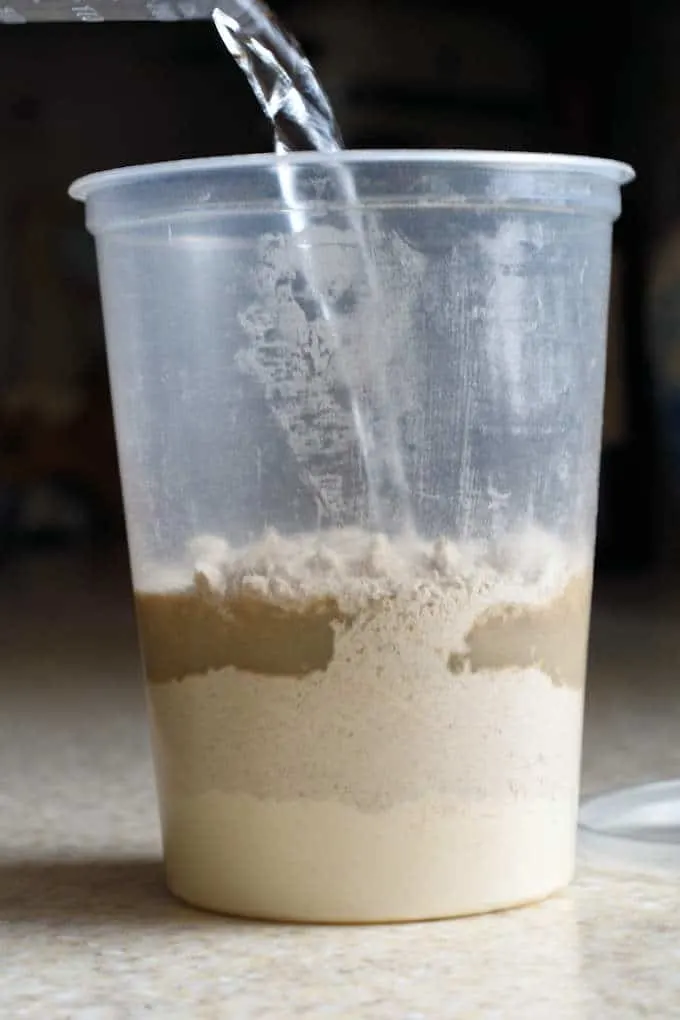
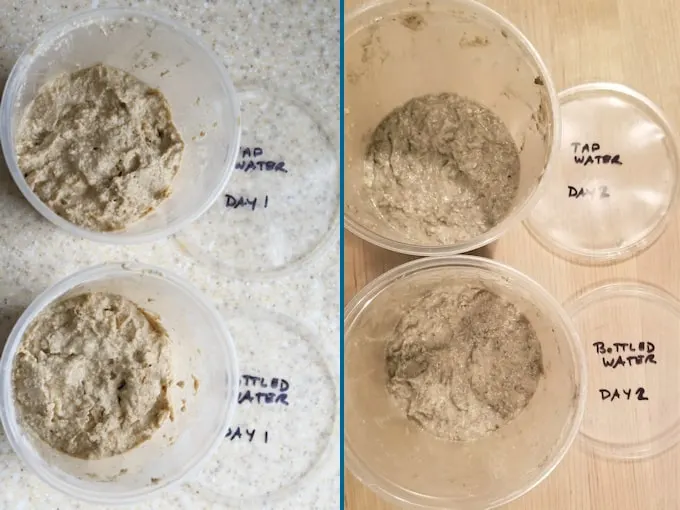
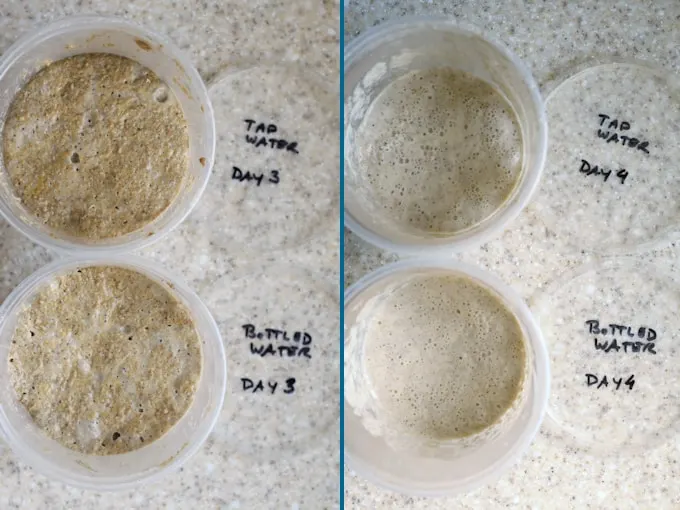

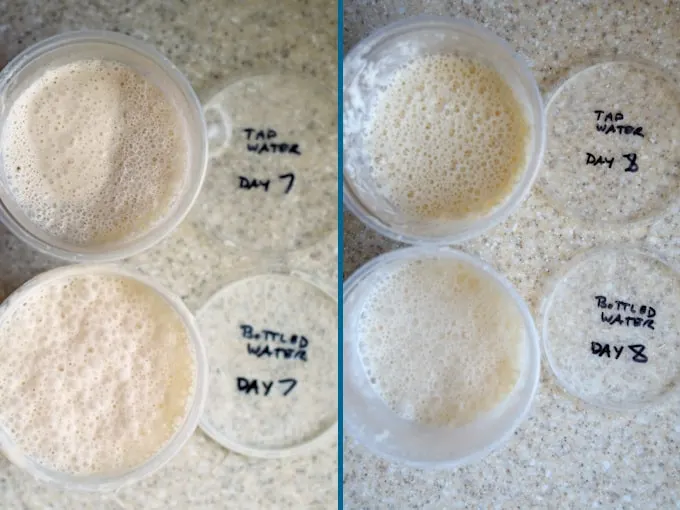
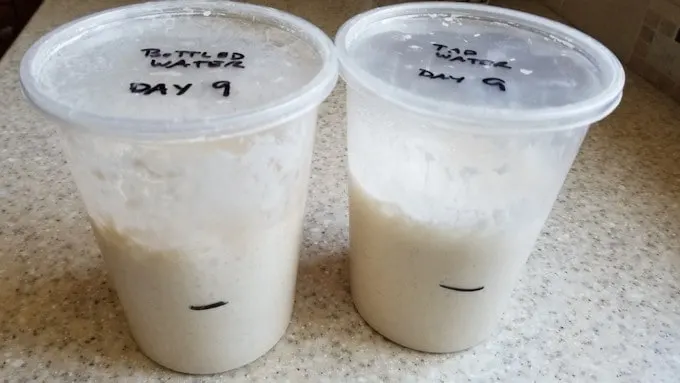
Daily Notes on My Sourdough Starter Progress:
- Day 1. Mixed at 11am.
- Day 2. No activity.
- Day 3. Doubled in volume, smells “grainy”, like wet rye. Not pungent. Fed at 11 am.
- Day 4. Rose to fill the container overnight, then collapsed. Smelled cheesy. Fed at 1 pm
- Day 5. Didn’t rise much, cheesy but less pungent, fed at 12 noon
- Day 6. Rose almost double. Smelled less cheesy, more sharp. Fed at 12 noon.
- Day 7. Rose to double and almost overflowed the container. No cheesy smell, just fermenty, yeasty smell.
- Day 8. Both rose to fill the container. No cheesy smell, smelled pleasantly fermented and yeasty. Ready to use.
- Day 9. Left at cooler room temp overnight. Rose to double in less than 6 hours and didn’t collapse by 24 hours. Nice yeasty, beery smell. First day baking.
Congratulations! You’ve done it! You’ve created a living batter filled with wild yeast. Now let’s see how to feed & maintain your sourdough starter. If you want to continue saving flour you can follow these instructions for How To Keep a Small Starter.
Now that you’ve got your starter ready, check out the entire list of My Best Sourdough Recipes. Have fun!
I know you hate to throw away that sourdough discard. Check out these recipes that use sourdough discard.
Finally, did you know you can dry your sourdough starter? It’s true. Dried starter can be stored at room temperature indefinitely without feeding.
If you love this recipe as much as I do, I’d really appreciate a star rating and a quick comment. Ratings and comments help my recipes show in search results. Thanks!
Sourdough Starter Recipe
Ingredients
- 1 oz unbleached all purpose flour
- 1 oz whole grain rye or whole wheat flour (see note)
- 2 oz water (room temperature)
- 10 oz unbleached all purpose flour (for feeding)
Instructions
- On Day 1, combine the all purpose flour, whole grain flour and water in a pint size glass or plastic container. Mix until it forms a thick batter. Loosely cover with plastic wrap or a lid.
- Set aside at warm room temperature (about 75°75 °F-80°F80 °F is ideal) until the mixture starts to bubble. The warmer the room temperature, the faster the starter will become active. This usually takes 48 hours, so there is no feeding on day 2.
- On day 3 weigh out 1 oz (28g) of the starter and discard the rest. Combine the reserved starter with 1 oz (28g) all purpose flour and 1 oz (28g) room temp water. Stir to form a thick batter, cover and set aside at warm room temperature for 24 hours. After 3 or 4 days the starter might smell cheesy. It’s fine. Keep feeding.
- On days 4, 5 and 6 feed with the same procedure. Weigh out 1 oz (28g) of the starter and discard the rest. Combine the reserved starter with 1 oz (28g) all purpose flour and 1 oz (28g) room temp water. Stir to form a thick batter, cover and set aside at warm room temperature for 24 hours.
- On day 7 weigh out 2 oz (56g) of the starter and discard the rest. Combine the reserved starter with 2 oz (56g) all purpose flour and 2 oz (56g) room temp water. Stir to form a thick batter, cover and set aside at warm room temperature for 24 hours.
- On day 8 you’ll need to transfer the starter to a quart size container. Weigh out 4 oz (112g) of the starter and discard the rest. Combine the reserved starter with 4 oz (112g) all purpose flour and 4 oz (112g) room temp water. Stir to form a thick batter, cover and set aside at warm room temperature for 6-24 hours.
- The starter is often ready at this point. The starter is ready to use for baking when it doubles in volume within 8 hours of feeding and has a pleasant, slightly fermented yeasty aroma. If that hasn’t happened by day 8 continue feeding until the starter is ready.
Would you like to save this recipe?
As an Amazon Associate and member of other affiliate programs, I earn from qualifying purchases.

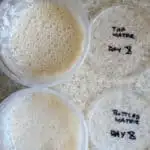

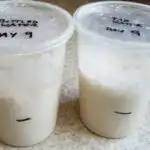



Up to stage 5 of the feeding Sourdough starter, can the discard portion be used? Such as in the Zucchini Discard Sourdough Bread recipe.
The starter goes through some pretty funky stages as it’s growing. I wouldn’t use the discard until you have an active, growing starter. Once it’s rising consistently and smells nice and yeast-y/ferment-y then the discard is good to use.
I’m a little confused. Is the starter ready to use only while it is doubled and only useful in discard recipes after it has fallen?
There are so so many ways and so many variables when working with sourdough. In general, I like to use my starter to bake when it has just reached peak activity. I use it as discard if it has passed it’s peak.
Sorry, I posted this in the feeding page on accident. I’m on day 6 of starting the starter and I’ve been following the directions. I went to feed it today and there’s a fuzzy white layer on top. When I put it in a jar is the jar supposed to be sealed or should it just be covered? I’ve had mine in a canning jar with plastic wrap over the opening and then the lid and seal on top of that.
If there is fuzzy stuff on it throw it away. The jar should be lightly covered. Just plastic wrap or the lid, ajar, is good. I think the mold might have taken hold because there was no breathing space.
Thank you. I’m trying it with plastic wrap. So far so good. It was doubled and bubbly about 36 hours in so I fed it woke up to it being doubled and bubbly about 12 hours later. Should I keep feeding it every 12 hours if it keeps doubling in that time frame?